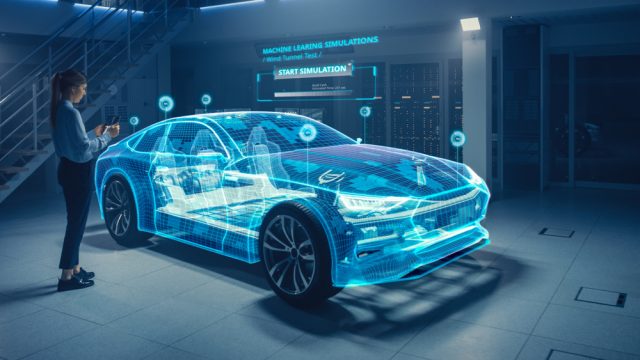
The German automotive industry: avant-garde or crisis?
 Thomas Schäfer, who recently became the head of Volkswagen, made a significant statement to his management team that caused quite a stir in the automotive market. He highlighted that the high costs of car production and maintenance, a drop in demand, and growing competition, particularly in the hybrid car market, are putting the future of the well-known car manufacturer at risk. Many highly competitive Asian manufacturers are also vying for a share of the market, which presents a significant challenge for Volkswagen.
Thomas Schäfer, who recently became the head of Volkswagen, made a significant statement to his management team that caused quite a stir in the automotive market. He highlighted that the high costs of car production and maintenance, a drop in demand, and growing competition, particularly in the hybrid car market, are putting the future of the well-known car manufacturer at risk. Many highly competitive Asian manufacturers are also vying for a share of the market, which presents a significant challenge for Volkswagen.
As a leader of an automotive group that includes prestigious brands such as Audi, Lamborghini, Ducati, Bentley, Porsche, SEAT, and Škoda, Volkswagen must address these challenges; otherwise, it could lead to the company’s implosion. This risk could have far-reaching effects on the German and European economies.
The year 2022 saw Volkswagen emerge as the largest car manufacturer globally, boasting a staggering turnover. In the first half of 2023, the company’s sales recorded an impressive 18% increase compared to the previous year, resulting in a revenue of 156 billion euros. However, it’s not just Volkswagen that’s enjoying a positive trend – two other German car manufacturers, BMW and Mercedes, are also in an enviable state. Despite this, entrepreneurs in Germany – particularly those in the automotive sector – have expressed concerns regarding the bureaucratic hurdles and the unstable geopolitical and geoeconomic climate between China, the European Union, and the Western world as a whole.
The automotive industry is facing a plethora of challenges that require immediate attention, and car manufacturers are at the forefront of these challenges. They must navigate multiple transformations simultaneously, such as the transition to electric vehicles and the development of software that meets market demands. The electrification of the fleet is a significant transformation that requires substantial investment in research and development, infrastructure, and manufacturing capabilities. In addition, the development of advanced software that can keep up with the evolving market demands for features such as autonomous driving, connectivity, and user interfaces is crucial.
There is a growing concern among industry experts that while car manufacturers may be able to weather the storm brought on by the emergence of new technologies such as electric vehicles, the same cannot be said for suppliers who produce parts for traditional combustion engines or gearboxes. These suppliers face significant risks and may not survive the shift towards electric vehicles.
This scenario could have far-reaching implications for the automotive industry as a whole, as the supply chain must be robust and resilient to ensure that the industry can continue to meet the demands of consumers worldwide. The transition to electric vehicles is a complex and multi-faceted process, and the success of this transition will depend on the ability of all players in the supply chain to adapt and innovate.
To ensure that the industry can meet the needs of consumers and remain competitive, the supply chain must be strong, agile, and adaptable. This means that suppliers must be able to pivot towards producing parts for electric vehicles, while also continuing to manufacture parts for traditional combustion engines and gearboxes as demand for these products gradually declines.
Overall, the success of the automotive industry in the coming years will depend on the ability of all players in the supply chain to navigate this complex transition and to work together to ensure that the industry can continue to meet the evolving needs of consumers around the world.
In particular, the German automotive industry is facing a significant challenge in China, which accounts for 40% of the revenue generated by the three major German car companies. However, China has emerged as a new commercial player in the automotive sector, and the trend has changed drastically. In 2022, Germany exported 2.6 million vehicles, while China exported approximately 3 million vehicles. This shift in the balance of power has significant implications for the German automotive industry, which has traditionally been one of the world’s leading car exporters. Therefore, the industry needs to act quickly and adapt to this changing landscape by investing in new technologies, expanding into new markets, and forming strategic partnerships with other players in the industry to ensure its continued success.
 In addition to this, it is important to note that as of now, there are also two major concerns that the automotive industry is grappling with. One is the current scenario, and the other is the ongoing ecological transition which is posing challenges to the industry’s sustainability. The Volkswagen Group has been experiencing a significant shortfall in the sales of electric vehicles. The sales figures are ranging from -30% to -70% depending on the brand and the market. Even in the Chinese market, which has a strong focus on electric vehicles, the Volkswagen brand has only been able to secure a 2% market share, putting it as a second-level partner. This issue has also been affecting employment in the sector, with only 3.5 million German cars being produced in Germany in 2022. Despite the sector directly employing 900,000 people between car manufacturers and external suppliers, the production numbers have been impacted by the low sales figures for electric vehicles.
In addition to this, it is important to note that as of now, there are also two major concerns that the automotive industry is grappling with. One is the current scenario, and the other is the ongoing ecological transition which is posing challenges to the industry’s sustainability. The Volkswagen Group has been experiencing a significant shortfall in the sales of electric vehicles. The sales figures are ranging from -30% to -70% depending on the brand and the market. Even in the Chinese market, which has a strong focus on electric vehicles, the Volkswagen brand has only been able to secure a 2% market share, putting it as a second-level partner. This issue has also been affecting employment in the sector, with only 3.5 million German cars being produced in Germany in 2022. Despite the sector directly employing 900,000 people between car manufacturers and external suppliers, the production numbers have been impacted by the low sales figures for electric vehicles.
The car, however, is a very important good to export: 16% of German exports are cars, representing over 50% of the gross value added of the European Union automotive sector. It is therefore inevitable that the German car sector represents a real European asset.
The German automotive industry, for its part, is deploying huge resources to keep up: they account for 35% of gross fixed investments in manufacturing, 42% of research and development, reaching 64% of research conducted by other companies, therefore not expressly linked to manufacturing production methods. Car manufacturers filed approximately half of the total patents in 2017, up compared to the same figure in 2005 (33%). This specific weight rises exponentially if we consider that all the companies have headquarters and factories in German cities and counties that did not previously enjoy a particularly thriving industrial sector. Suffice it to say that 47% of workers in Wolfsburg – the city where Volkswagen is based – are employed in the automotive sector, or the Land of Baden-Württemberg where Mercedes-Benz, Porsche and Bosch are based. There would therefore not be a “general” economic crisis if the market encountered a serious contraction, rather there would be many disastrous local crises, which would undermine Germany’s social cohesion.
Another problem is caused by the reputation of the brand: the “Dieselgate” of 2015 led to a decline of 166,000 cars of other German brands in America, with a loss of revenue equal to 7.7 billion dollars (-25% in 2014). German political support for the sector certainly declined after that case, yet strong tax breaks for company cars remained, which allow employees to give up part of their salary in exchange for a high-end – German – vehicle: just think that almost 70% of new cars in Germany are purchased by companies and are mainly used for personal travel by employees.
However, there is no shortage of voices from economists and consultants who point out that a “salvation at all costs” of the automotive sector could lead to bigger crises. “Cars are the greatest manifestation of Germany’s total attention to mechanical engineering. The ongoing problems with Volkswagen software underline that it will be difficult to reinvent itself in an increasingly digitalized world when the economic system is optimized to churn out expensive mechanical marvels,” says Christoph Bornschein, consultant at TLGG. Rüdiger Bachmann, of the University of Notre Dame, echoes this: “By placing a little more faith in market forces, German politicians would see that an economic space would open up that could be easily filled in the event of a decline in German automotive production.”
Economic space that would be covered by the development of alternative mobility services to the car – and with positive effects also on the environment – or by greater demand in the IT sector, also converting the field of study favored by German students, who could progressively reduce enrollments in mechanical engineering to favor new specialties. There would be a need for fewer subsidies, which could easily be reconverted into more capital available for innovative start-ups in other sectors.
But can we consider the phenomenon being just to a local level? local crises? There are examples of local crises that have turned out to be positive experiences for the communities affected. A good example is Eindhoven, the “capital” of Dutch Philips, which is now home to thousands of small companies that primarily produce chips. This has made the city one of the wealthiest in Europe. Similarly, Espoo, the headquarters of Nokia, saw success when it began producing telecommunications network equipment after the company closed. Even in the case of Wolfsburg, suppliers could continue working with other car manufacturers, and Volkswagen itself could convert its production to high-end vehicles at low production speeds or become a pioneer in sustainable mobility strategies. Therefore, there are various ways in which a crisis can be turned into an opportunity for growth and development.
It is crucial to consider that a sector, that is incredibly significant and represents European excellence worldwide, should not be given political and institutional aid in an environment of unfair competition with other countries. The proposed regulation to prohibit the production of cars equipped with combustion engines from 2034 appears to be a mere tactic to support German manufacturers in disposing of their unsold electric vehicles rather than a genuine environmental strategy. This move would create an unjust playing field in the automobile industry, providing German manufacturers with an unfair advantage over their competitors.



 Subscribe
Subscribe